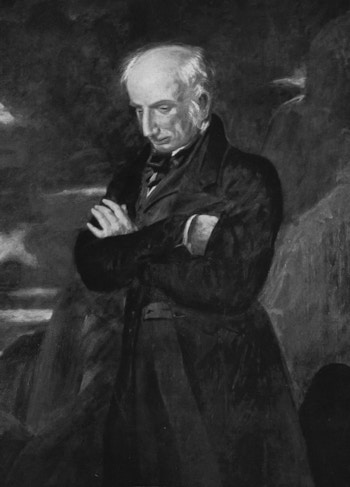
Seminal Romantic poet William Wordsworth was born in 1770 in Cockermouth, Cumbria, England, one of five children of the lawyer John Wordsworth. In his early years, he showed a deep interest in both nature and literature, exploring his rural surroundings and memorizing poems at his father’s behest. After the death of Wordsworth’s mother, Ann, when he was eight, he was sent to grammar school. In 1787, he began to attend St. John’s College, Cambridge, and saw his poetry published for the first time in The European Magazine.
He and a friend embarked on a walking tour of the Alps in 1790, visiting France, Italy, and Switzerland. France was then in the throes of the French Revolution, and Wordsworth was entranced by its radical Republican politics. He returned to France the following year, where he began writing his Descriptive Sketches and fell in love with a young Frenchwoman, Annette Vallon, who bore his child in 1792. Due to his precarious financial situation, he was forced to return to England soon thereafter, reneging on his stated aim of marrying Vallon.
In 1795, Wordsworth received a bequest of £900 from a benefactor, a sum large enough to allow him to pursue a career as a poet. He reconnected with his sister, Dorothy, and met Samuel Taylor Coleridge, forming the trio apocryphally called “three persons and one soul.” The three traveled, philosophized, and observed the natural world together. During these fruitful years Wordsworth and Coleridge collaborated on the foundational Romantic volume Lyrical Ballads, which included both “Tintern Abbey” and Coleridge’s “The Rime of the Ancient Mariner.” Wordsworth also began work on his famed Prelude, which would be published after his death. He, Dorothy, Coleridge, and Robert Southey all lived as neighbors for a time in Grasmere in England’s idyllic Lake District, earning them the moniker of the “Lake Poets.”
Wordsworth married Mary Hutchinson in 1802, a friend from his schooldays with whom he would have five children, two of whom died before reaching adulthood. The couple and their children continued to live with Dorothy, who was an affectionate member of the family despite her inconsistent health. Wordsworth published Poems, In Two Volumes in 1807, capping his “great decade”; though he continued to write and publish, his later poetry never reached the same level of acclaim as his previous work. Wordsworth secured patronage from the Earl of Lonsdale and the post of Distributor of Stamps in 1812, and the family became financially stable enough to move to Rydal Mount in Ambelside, which became their permanent home.
Despite broad criticism of Wordsworth’s innovative works early in his career, his reputation improved during his later years, until he was widely regarded as a preeminent figure of British poetry. His honors included an appointment as Poet Laureate for the last seven years of his life. He died of pleurisy in 1850.
-
More Wordsworth
Text: Read poems by Wordsworth at the Poetry Foundation
Text/Visual: Learn about the Wordsworths and explore online exhibitions at Wordsworth Grasmere
Text: Flip through a digitized 1890 reprinting of the 1798 Lyrical Ballads at Internet Archive